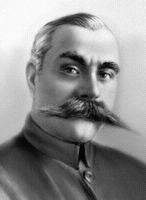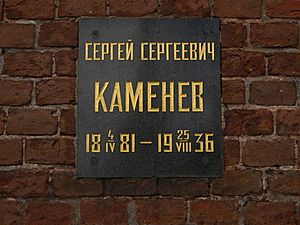Sergey Kamenev facts for kids
Quick facts for kids
Sergey Kamenev
|
|
|---|---|
 |
|
| Birth name | Sergey Sergeyevich Kamenev |
| Born | 16 April 1881 Kiev, Russian Empire |
| Died | 25 August 1936 (aged 55) Moscow, Russian SFSR, Soviet Union |
| Allegiance | |
| Service/ |
Imperial Russian Army Red Army |
| Years of service | 1898–1936 |
| Rank | Polkovnik (Russia) Komandarm 1st rank (Soviet) |
| Battles/wars | First World War Russian Civil War Polish–Soviet War |
Sergey Sergeyevich Kamenev (Russian: Серге́й Серге́евич Ка́менев; April 16, 1881 – August 25, 1936) was an important Soviet military leader. He reached the high rank of Komandarm 1st rank, which is like a top general.
Kamenev was born in Kiev, a city in what was then the Russian Empire. He fought in World War I as a colonel. Later, he joined the All-Union Communist Party (Bolsheviks) in 1918. In July 1919, he became the Commander-in-chief of the Red Army during the Russian Civil War. This was a very important job. He was also part of the Revolutionary Military Council of the USSR from 1924 to 1927. Kamenev died from a heart attack on August 25, 1936.
Contents
Early Life and Training
Sergey Kamenev was born in Kiev into a noble family. His father was an artillery colonel and an engineer. As a child, Sergey dreamed of becoming a surgeon. However, he chose a military career instead.
He went to the Vladimir Kiev Cadet Corps and then the Aleksandrovsk Military School. He finished third in his class in 1900. After serving in an infantry regiment, he attended the Nikolaev Academy of the General Staff. He graduated with high honors in 1907.
Before World War I, Kamenev worked in different military districts. He also taught tactics and how to read maps at a military school. He took part in many military exercises. This helped him become a skilled officer and commander.
World War I Experience
Kamenev joined the front lines of the First World War as a captain. He worked as a senior assistant for the 1st Army. Later, he commanded the 30th Poltava Infantry Regiment. His superiors saw him as an "outstanding General Staff officer and an excellent combat commander." They thought he deserved to become a general officer.
As a colonel leading his regiment, Kamenev was a strong commander. He was brave, organized, and calm. He cared about his officers and soldiers. Because he looked after his soldiers, they chose him as their commander in 1917.
Kamenev also served as Chief of Staff for the XV Army Corps and the 3rd Army. During this time, he mostly handled getting troops ready to leave the army. His service in the Imperial Army ended when his headquarters moved to Nizhny Novgorod.
Joining the Red Army
Kamenev had experience working with soldiers' councils. He joined the Red Army early on as a military expert. He wanted to keep fighting against outside enemies. At first, he did not want to be involved in the Russian Civil War.
From April 1918, Kamenev worked on the Western Front. His job was to protect Soviet Russia from Germany. When he started, the Red Army had many problems. These included soldiers acting on their own, not following orders, and deserting.
In August 1918, Kamenev became an assistant military leader. He was in charge of the Smolensk region. His tasks included taking over areas from the Germans and forming new divisions for the Red Army. Under his leadership, the Vitebsk division and the Roslavl detachment were quickly formed. They were sent to the Eastern Front.
Victory Against Kolchak
Kamenev started getting promoted to important positions in late 1918. In September 1918, he became the commander of the Eastern Front. He took over from Jukums Vācietis. The fight against the Whites was happening in the Volga region. By October 1918, Kamenev's troops pushed the enemy away from the Volga.
In late 1918 and early 1919, the Reds captured Ufa and Orenburg. But then, Kolchak's armies attacked in the spring. The Reds had to give up these cities, and the front moved back to the Volga.
In 1919, Kamenev played a key role in defeating Admiral Kolchak's armies. He led a successful counterattack that pushed Kolchak east of the Urals mountains. Kamenev wanted to chase Kolchak into Siberia. But Leon Trotsky and Vācietis said no, fearing a trap. Later, Trotsky admitted Kamenev was right. By this time, Kamenev had gained the support of Vladimir Lenin.
Commander-in-Chief of the Red Army
Kamenev admitted he didn't fully understand politics. He saw it "as if in a fog." A Communist leader named S.I. Gusev helped Kamenev learn more about politics. In July 1919, the previous commander-in-chief, Vatsetis, was removed from his post. Kamenev became the new commander-in-chief of all armed forces. This was the highest military position a non-party officer could hold in Soviet Russia. Pavel Pavlovich Lebedev, a skilled former Tsarist general, became Kamenev's closest helper.
Kamenev led the fight against General Anton Denikin's forces. Denikin was advancing on Moscow. Kamenev had a plan to fight Denikin. However, his plan was outdated because Kolchak had already been defeated. Kamenev insisted on his plan, which involved attacking through the Don region. This area had strong resistance from anti-Bolshevik Cossacks.
Leon Trotsky disagreed with Kamenev's plan, but Vladimir Lenin supported it. As a result, the Reds failed their August attack. The Whites got very close to Moscow, threatening the main Soviet weapons supply in Tula. This put Soviet Russia at risk.
Plans had to be changed quickly. The situation was saved by different fronts working together. Kamenev also led battles against General Yudenich near Petrograd. He led forces against the Poles during the Polish-Soviet War. Kamenev also planned the attack on Poland. He fought against General Wrangel in the South, even helping plan the Perekop-Chongarskoy operation.
After the main Civil War ended in November 1920, Kamenev led operations to stop banditry and peasant uprisings. He also helped put down an uprising in Karelia. He went to the battle area himself. He led the fight against the Basmachi in Turkestan. During this fight, a leader named Enver Pasha, who opposed the Bolsheviks, was defeated.
Military Assessment
War Commissar Leon Trotsky gave an important opinion about Kamenev:
It is hard to say which of the two colonels (Vatsetis and Kamenev) was more talented. Both were good at strategy and had experience from a big war. Both were hopeful, which is important for a commander. Vatsetis was more stubborn and easily influenced by people against the revolution. Kamenev was much easier to work with and listened to the Communists who worked with him... Kamenev was a capable commander with good strategic ideas and was willing to take risks. He just needed more depth and firmness.
Overall, Kamenev had Lenin's trust. Under Kamenev's leadership, the Red Army defeated its enemies and won the Civil War. He strongly believed in attacking as the best way to fight in the Civil War. He was a major military leader. Because of the tough conditions of the Civil War, he had to be very careful with the party leaders.
Awards and Honors

For his actions during the Civil War, Kamenev received the Order of the Red Banner. He also received other special awards. In April 1920, he was given a Golden Weapon of Honor (a saber) for his victories on the Eastern Front. In January 1921, he received an honorary Mauser pistol with the Order of the Red Banner on its handle.
In the summer of 1922, Kamenev received the Order of the Red Star of the 1st degree from the Bukhara People's Soviet Republic. This was for his work against Enver Pasha. In September 1922, he received the military order of the Red Banner from the Khorezm autonomous Soviet republic. This was for helping the people of Khorezm and for fighting against enemies. Along with Semyon Budyonny, he was one of the most decorated Red officers of the Civil War.
Later Life and Legacy
After the Civil War, Kamenev continued to work on making the Red Army stronger. He wrote military books and gave lectures about his experiences in World War I and the Civil War. He helped create new rules for the Red Army.
After his role as commander-in-chief ended in 1924, he held several other important positions. He was an inspector of the Red Army, Chief of Staff, and Deputy Commissar for Military and Naval Affairs. From 1934 to 1936, he led the Air Defense Directorate of the Red Army. In this role, he greatly improved the country's air defenses with new equipment.
Kamenev also helped start Osoaviakhim. This was a Soviet organization that supported the army and military industry. He also helped explore the Arctic as chairman of the government's Arctic Commission.
Kamenev joined the Communist Party in 1930. He died from a heart attack before he could be affected by the Great Purge. His ashes were buried in the Kremlin Wall Necropolis. However, after his death, his name and work were forgotten for many years. Later, his name was cleared, and his contributions were recognized again.
Military Career Highlights
- 1918–1919: Commander of the Eastern Front during the Civil War
- 1919–1924: Commander-in-chief of the Armed Forces of the Republic
- April 1924 – March 1925: Inspector of the Red Army
- March 1925 – November 1925: Chief of the Staff of the Red Army
- November 1925 – August 1926: Chief Inspector of the Red Army
- August 1926 – May 1927: Chief of the Main Directorate of the Red Army
- May 1927 – June 1934: Deputy Minister in the Ministry of Military and Navy Forces and deputy chairman of the Revolutionary Military Council of the USSR
- From 1934: Head of the Air Defence Department of the Red Army
Decorations and Awards
- Honorary Revolutionary Weapon (sword and pistol) with the Order of the Red Banner
- Order of the Red Banner of the RSFSR
- Order of the Red Banner of the Khorezm SSR
- Red Crescent First Class of the Bukhara People's Soviet Republic
See also
 In Spanish: Serguéi Kámenev para niños
In Spanish: Serguéi Kámenev para niños

